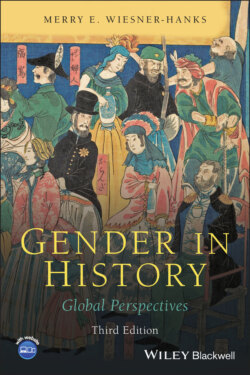Читать книгу Gender in History - Merry E. Wiesner-Hanks - Страница 14
Gender History as a Field
ОглавлениеThis discussion of scholarly trends may make it appear as if using gender as a category of analysis has swept the discipline of history, with scholars simply choosing the approach or topic they prefer. This is far from the actual situation. There are still many historians who continue to view focusing on gender as a new-fangled fad, or, conversely, as an old-fashioned approach no longer needed in postfeminist world. As noted above, until very recently, books that explicitly take a world, global, or transnational perspective have focused largely on economic and political developments without examining their gendered nature. Other historians invoke “gender” without really thinking through its implications for their interpretations of the past. Though titles like “man the artist” have largely disappeared, as most authors – or their editors – have recognized their false universality, books still divide their subjects into “artists” and “women artists” or “rulers” and “women rulers.”
Studies of women and gender are also very unevenly distributed geographically and chronologically. Books on women’s experience or that use gender as a category of analysis in the twentieth-century United States or early modern England, for example, number in the hundreds, while those that focus on Kiribati or Kazakhstan may be counted on one hand. This unevenness is related, not surprisingly, to uneven growth in women’s and gender studies programs, which is in turn related to the structure of higher education around the world and the ability or willingness of institutions of higher education to include new perspectives and programs. By the late 1970s, hundreds of colleges and universities in the United States and Canada offered courses in women’s history, and many had separate programs in women’s history or women’s studies. Universities in Britain, Australia, the Netherlands, and the Scandinavian countries added courses and programs a bit more slowly, and other developed countries were slower still, though by the 1990s courses in women’s history were introduced in India, China, Korea, and elsewhere, especially at women’s universities. In Japan and elsewhere, much of the research on women has been done by people outside the universities involved with local history societies or women’s groups, so has not been regarded as scholarly.
Scholars and students in some countries in the early twenty-first century still report that investigating the history of women, gender, or sexuality can get them pegged as less than serious and be detrimental to their future careers as historians. Added to this is backlash against women’s and LGBTQ+ rights, and sometimes to the entire concept of gender, in countries headed by authoritarian men who advocate traditional gender roles. Brazil’s President Jair Bolsonaro, for example, elected in 2018, has attacked what he terms “gender ideology,” by which he means policies aimed at improving gender equality and lessening homophobia. Hungary’s Prime Minister Viktor Orbán offered tax benefits and subsidies to women who had at least four children and banned gender studies from Hungarian universities. In 2020 the Hungarian Parliament voted to stop transgender and intersex people from legally changing their gender. Gender- and sexuality-based violence has increased in Brazil and Hungary, as well as in other countries with right-wing populists in charge.
The history done in any country, not simply Brazil and Hungary, is shaped by regional and world politics, and issues other than gender have often seemed more pressing to historians in Latin America, Eastern Europe, and other parts of the world where political and economic struggles have been intense. Universities and researchers in developing countries also have far fewer resources, which has hampered all historical research and limited opportunities for any new direction. Thus an inordinate amount of the work in the history of women, gender, and sexuality, including that which focuses on the continent of Europe and many other parts of the world, has been done by English-speaking historians, and the amount of research on English-speaking areas far outweighs that on the rest of the world. There is also imbalance within English-speaking areas, for studies of the United States vastly outnumber those of anywhere else.
There are signs that this imbalance is changing somewhat, as organizations to promote the history of women, gender and sexuality, and academic women’s/gender/sexuality studies programs are gradually being established in more countries, sometimes at great risk to those who organize them. Yet the head start of English-language scholarship, combined with the ability of many students and scholars throughout the world to read English – and the inability of many English-speaking students and scholars to read anything but English – have meant that the exchange of theoretical insights and research results has to this point been largely a one-way street.
